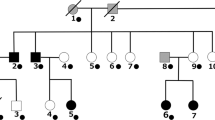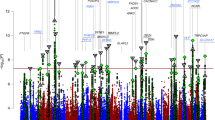Abstract
Bipolar affective disorder is one of the most common mental illnesses with a population prevalence of approximately 1%. The disorder is genetically complex, with an increasing number of loci being implicated through genetic linkage studies. However, the specific genetic variations and molecules involved in bipolar susceptibility and pathogenesis are yet to be identified. Genetic linkage analysis has identified a bipolar disorder susceptibility locus on chromosome 4q35, and the interval harbouring this susceptibility gene has been narrowed to a size that is amenable to positional cloning. We have used the resources of the Human Genome Project (HGP) and Celera Genomics to identify overlapping sequenced BAC clones and sequence contigs that represent the region implicated by linkage analysis. A combination of bioinformatic tools and laboratory techniques have been applied to annotate this DNA sequence data and establish a comprehensive transcript map that spans approximately 5.5 Mb. This map encompasses the chromosome 4q35 bipolar susceptibility locus, which localises to a ‘most probable’ candidate interval of approximately 2.3 Mb, within a more conservative candidate interval of approximately 5 Mb. Localised within this map are 11 characterised genes and eight novel genes of unknown function, which together provide a collection of candidate transcripts that may be investigated for association with bipolar disorder. Overall, this region was shown to be very gene-poor, with a high incidence of pseudogenes, and redundant and novel repetitive elements. Our analysis of the interval has demonstrated a significant difference in the extent to which the current HGP and Celera sequence data sets represent this region.
This is a preview of subscription content, access via your institution
Access options
Subscribe to this journal
Receive 12 print issues and online access
$259.00 per year
only $21.58 per issue
Buy this article
- Purchase on Springer Link
- Instant access to full article PDF
Prices may be subject to local taxes which are calculated during checkout

Similar content being viewed by others
References
Weissman MM, Leaf PJ, Tischler GL, Blazer DG, Karno M, Bruce ML, Florio LP . Affective disorders in five United States communities Psychol Med 1988; 18: 141–153
Owen MJ, Cardno AG . Psychiatric genetics: progress, problems, and potential Lancet 1999; 354 Suppl 1: SI11–SI14
Owen MJ, Cardno AG, O'Donovan MC . Psychiatric genetics: back to the future Mol Psychiatry 2000; 5: 22–31
Craddock N, Jones I . Molecular genetics of bipolar disorder Br J Psychiatry 2001; 178 (Suppl 41): S128–S133
Adams LJ, Mitchell PB, Fielder SL, Rosso A, Donald JA, Schofield PR . A susceptibility locus for bipolar affective disorder on chromosome 4q35 Am J Hum Genet 1998; 62: 1084–1091
Friddle C, Koskela R, Ranade K, Hebert J, Cargill M, Clark CD et al. Full-genome scan for linkage in 50 families segregating the bipolar affective disease phenotype Am J Hum Genet 2000; 66: 205–215
Willour VL, Zandi PP, MacKinnon DF, Simpson SG, Potash JB, Gershon ES et al. Genome scan on fifty-six multiplex bipolar pedigrees collected by the NIMH genetics initiative (Bipolar Disorder) [Abstract] Am J Hum Genet 2001; 69: (Supplement): 527
Badenhop RF, Moses MJ, Scimone A, Adams LJ, Kwok JBJ, Jones A-M et al. Genetic refinement of a probable disease haplotype and physical mapping of a 2.3 Mb region defining a bipolar affective disorder susceptibility locus on chromosome 4q35 Am J Med Genet (submitted)
Altschul SF, Gish W, Miller W, Myers EW, Lipman DJ . Basic local alignment search tool J Mol Biol 1990; 215: 403–410
International human genome sequencing consortium. Initial sequencing and analysis of the human genome Nature 2001; 409: 860–921
Venter CJ, Adams MD, Myers EW, Li PW, Mural RJ, Sutton GG et al. The sequence of the human genome Science 2001; 291: 1304–1351
Schuler GD . Electronic PCR: bridging the gap between genome mapping and genome sequencing Trends Biotechnol 1998; 16: 456–459
Burge C, Karlin S . Prediction of complete gene structures in human genomic DNA J Mol Biol 1997; 268: 78–94
Gyapay G, Schmitt K, Fizames C, Jones H, Vega-Czarny N, Spillett D et al. A radiation hybrid map of the human genome Hum Mol Genet 1996; 5: 339–346
van Geel M, Heather LJ, Lyle R, Hewitt JE, Frants RR, de Jong PJ . The FSHD region on human chromosome 4q35 contains potential coding regions among pseudogenes and a high density of repeat elements Genomics 1999; 61: 55–65
van Deutekom JC, Lemmers RJ, Grewal PK, van Geel M, Romberg S, Dauwerse HG et al. Identification of the first gene (FRG1) from the FSHD region on human chromosome 4q35 Hum Mol Genet 1996; 5: 581–590
Grewal PK, van Geel M, Frants RR, de Jong P, Hewitt JE . Recent amplification of the human FRG1 gene during primate evolution Gene 1999; 227: 79–88
Wijmenga C, Frants RR, Brouwer OF, Moerer P, Weber JL, Padberg GW . Location of facioscapulohumeral muscular dystrophy gene on chromosome 4 Lancet 1990; 336: 651–653
Tawil R, Figlewicz DA, Griggs RC, Weiffenbach B FSH Consortium. Facioscapulohumeral dystrophy: a distinct regional myopathy with a novel molecular pathogenesis Ann Neurol 1998; 43: 279–282
Allingham RR, Seo B, Rampersaud E, Bembe M, Challa P, Liu N et al. A duplication in chromosome 4q35 is associated with hereditary benign intraepithelial dyskeratosis Am J Hum Genet 2001; 68: 491–494
Jiao X, Munier FL, Iwata F, Hayakawa M, Kanai A, Lee J et al. Genetic linkage of Bietti crystallin corneoretinal dystrophy to chromosome 4q35 Am J Hum Genet 2000; 67: 1309–1313
Roby P, Eyre S, Worthington J, Ramesar R, Cilliers H, Beighton P et al. Autosomal dominant (Beukes) premature degenerative osteoarthropathy of the hip joint maps to an 11-cM region on chromosome 4q35 Am J Hum Genet 1999; 64: 905–909
Häfner FM, Salam AA, Linder TE, Balmer D, Baumer A, Schinzel AA et al. A Novel locus (DFNA24) for prelingual nonprogressive autosomal dominant nonsyndromic hearing loss maps to 4q35-qter in a large Swiss German kindred Am J Hum Genet 2000; 66: 1437–1442
Yu A, Zhao C, Fan Y, Jang W, Mungall AJ, Deloukas P et al. Comparison of human genetic and sequence-based physical maps Nature 2001; 409: 951–953
van Geel M, van Deutekom JC, van Staalduinen A, Lemmers RJ, Dickson MC, Hofker MH et al. Identification of a novel beta-tubulin subfamily with one member (TUBB4Q) located near the telomere of chromosome region 4q35 Cytogenet Cell Genet 2000; 88: 316–321
Cowan NJ, Wilde CD, Chow LT, Wefald FC . Structural variation among human beta-tubulin genes Proc Nat Acad Sci USA 1981; 78: 4877–4881
Lee MG-S, Lewis SA, Wilde CD, Cowan NJ . Evolutionary history of a multigene family: an expressed human beta-tubulin gene and three processed pseudogenes Cell 1983; 33: 477–487
Cleveland DW, Sullivan KF . Molecular biology and genetics of tubulin Ann Rev Biochem 1985; 54: 331–365
Floyd-Smith GA, de Martinville B, Francke U . A beta-tubulin expressed gene M40 (TUBB)) is located on human chromosome 6 and two related pseudogenes are located on chromosomes 8 (TUBBP1) and 13 (TUBBP2) Cytogenet Cell Genet 1985; 40: 629
Ozawa K, Murakami Y, Eki T, Soeda E, Yokoyama K . Mapping of the gene family for human heat-shock protein 90-alpha to chromosomes 1, 4, 11, and 14 Genomics 1992; 12: 214–220
Vamvakopoulos NC, Griffin CA, Hawkins AL, Lee C, Chrousos GP, Jabs EW . Mapping the intron-containing human hsp90 alpha (HSPCAL4) gene to chromosome band 14q32 Cytogenet Cell Genet 1993; 64: 224–226
Ponting C, Schultz J, Bork P . SPRY domains in ryanodine receptors (Ca2+-release channels) Trends Biochem Sci 1997; 22: 193–194
Brzezinski A . Melatonin in humans N Engl J Med 1997; 336: 186–195
Reppert SM, Weaver DR, Ebisawa T . Cloning and characterization of a mammalian melatonin receptor that mediates reproductive and circadian responses Neuron 1994; 13: 1177–1185
Pacchierotti C, Iapichino S, Bossini L, Pieraccini F, Castrogiovanni P . Melatonin in psychiatric disorders: a review on the melatonin involvement in psychiatry Front Neuroendocrinol 2001; 22: 18–32
Acknowledgements
This study was supported by the National Health and Medical Research Council (Australia) via grants to the Garvan Institute of Medical Research (Block Grant 993050), the Mood Disorders Unit, Prince of Wales Hospital (Program Grant 993208), the Network of Brain Research into Mental Disorders (Unit Grant 983302), and by a research contract from Merck & Co and Merck Sharpe Dohme, Australia through PsyGene Pty Ltd, and by the New South Wales Health Department Infrastructure Grant Program.
Author information
Authors and Affiliations
Corresponding author
Rights and permissions
About this article
Cite this article
Blair, I., Adams, L., Badenhop, R. et al. A transcript map encompassing a susceptibility locus for bipolar affective disorder on chromosome 4q35. Mol Psychiatry 7, 867–873 (2002). https://doi.org/10.1038/sj.mp.4001113
Received:
Revised:
Accepted:
Published:
Issue Date:
DOI: https://doi.org/10.1038/sj.mp.4001113
Keywords
This article is cited by
-
Positional cloning, association analysis and expression studies provide convergent evidence that the cadherin gene FAT contains a bipolar disorder susceptibility allele
Molecular Psychiatry (2006)
-
A 4q35.2 subtelomeric deletion identified in a screen of patients with co-morbid psychiatric illness and mental retardation
BMC Medical Genetics (2004)



